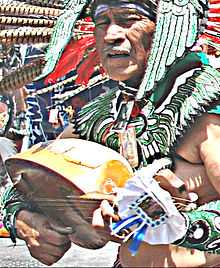Concheros string instruments

The concheros string instruments are Mexican plucked instruments that consist of three variants:
- mandolino de concheros or mandolina conchera: with 4 double courses (8 strings)
- vihuela de concheros or vihuela conchera: with 5 double courses (10 strings)
- guitarra de concheros or guitarra conchera: with 6 double courses (12 strings)
In their structure these instruments have a concha (armadillo shell), a shell-like wood body or a gourd as resonance box. These instruments are used by Concheros dancers for singing at "velaciones" (nighttime rituals) and for dancing at "obligaciones" (dance obligations).
History
Soon after the arrival of the Spanish invaders in 1519, the indigenous musicians and instrument makers of central Mexico, eagerly took up European instruments. The copied the Lute, the Chirimia (a primitive version of the Oboe that came from the Muslims of North Africa), the mandolin, and the violin. The native instrument makers were so adept at creating beautiful sounding instruments, that soon the Spanish crown forbid the locals from making instruments, because this was taking business from the Spanish instrument makers of Europe and colonial Mexico. Because the indigenous luthiers could no longer have access to the wood necessary to create the string instruments, especially the wood for the back of the guitars and mandolins, they soon resorted to using the shell of the armadillo This gave rise to the name commonly used for the indigenous/mestizo dance tradition known as the Concheros (the shell people).
Other Names for the Conchas
The dancers who use the conchas call them "Mecahuehuetl" (from Nahuatl Meca(tl) = chord + Huehue(tl)= old one "drum". This name reflects the fact that the early Conchero dancers where able to encrypt the precolumbian rhythms and steps of their agrarian rituals into the musical chords of the guitars and mandolins. A traditional conchero can tell which step should be carried out by how the melody is being strum on the conchas. Another name used for the armadillo-shelled instruments is "Chihuanda." The etymology of this term is uncertain, with Tarascan (Purepecha) seen as the most commonly agreed to root.
References
- Atlas Cultural de México. Música. México: Grupo Editorial Planeta. 1988. ISBN 968-406-121-8. Unknown parameter
|name=ignored (|author=suggested) (help)
- The rituals of kindness: The influence of the Danza Azteca tradition of central Mexico on Chicano-Mexcoehuani identity and sacred space (PhD). The Claremont Graduate University. pp. 113-147. Docket 3364048. 2009. Unknown parameter
|name=ignored (|author=suggested) (help)
External links
- Video Youtube - Mandolinas de concha
- Video Youtube - Mandolina de concha
- Photo of a mandolina de concha
- Photo of a conchero
| |||||||||||||||||